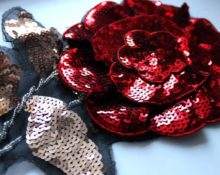For work you will need the following tools and materials:
- felt or felt;
- scissors;
- matches or lighter;
- safety pin;
- beads as decoration;
- needle and thread;
- a piece of thick cardboard.
The first step is to cut out cardboard templates. To do this, circles of various diameters are cut out of cardboard, for example, 7, 8 and 9 cm. Four blanks of each size are made from organza according to a template. To do this, you can fold it in four and carefully cut everything out in one go. Next, the resulting circles are folded in half twice, a cut is made along the fold line, not reaching a centimeter from the edge. Next, holding the uncut part, you need to cut the corners on the workpiece. It turns out four petals with a whole middle. The petals are scorched with a match or lighter, and the space between the petals is also singed.
Next, the assembly of the flower begins. A needle and thread are threaded through a piece of cardboard, and the petals are threaded onto it in decreasing order, while straightening them.After the process is completed, the needle is removed, the petals are stitched several times and beads are sewn into the center of the flower for beauty. To make a brooch from a flower, cut a circle out of felt fabric with a diameter slightly larger than the length of a safety pin. Holes are made in the fabric for a pin, and the pin is glued to the flower.
How to carefully make organza flowers
To make a flower neat, you need to master some flower making techniques, at least their basics:
- hand twisting, a similar technique is used to make flowers using satin ribbons;
- classical technique;
- ganutel - the use of wire, fishing line or threads to form petals of the desired design;
- a heat treatment method that also allows you to give the workpiece the required shape.
The most common are the last two techniques listed above.
When using the classical technique, the petals are first starched with a special composition. Next, using a specialized loaf, petals of the required design are made. They are made using a cardboard template.
Heat treatment began to be carried out with the advent of viscose and polyester, since synthetics melt under high temperature, changing their shape. Due to this property, the petals easily take the desired shape.
DIY chiffon and organza flowers: step-by-step master class with photos
Required tools and materials
To work you will need:
- organza or chiffon of various bright colors;
- lighter or candle;
- a piece of felt;
- accessories (beads, glass beads, rhinestones);
- scissors;
- tweezers;
- needle and thread;
- glue gun;
- clasp for a brooch, for example, a safety pin.
Stages of work
 The fabric is smoothed with an iron, after which circles of various diameters are cut out of it. After this, the edges of all the circles are singed with a lighter or candle, after which the circles are folded into a flower and carefully stitched. The center of the flower is decorated with decorative fittings, for example, beads. A pin is sewn or glued on the back side to secure the brooch. The result was a luxurious, bright flower.
The fabric is smoothed with an iron, after which circles of various diameters are cut out of it. After this, the edges of all the circles are singed with a lighter or candle, after which the circles are folded into a flower and carefully stitched. The center of the flower is decorated with decorative fittings, for example, beads. A pin is sewn or glued on the back side to secure the brooch. The result was a luxurious, bright flower.
Secrets of harmonious color combinations
You can apply the principle of complementary combination, that is, using the Itten circle, identify two contrasting colors and use them in the composition.
Also, using the Itten circle, you can create a triad of colors by inscribing a regular equilateral triangle in the circle, the angles of which will indicate the desired colors.
Similar combination - take from two to five similar shades, located close to each other on the Itten circle, to obtain a low-contrast, calm color composition. The scheme works with both muted tones and bright shades.
You can use a separate and complementary combination of colors, in which one color will be the main color and two additional ones. The contrast of the scheme will be slightly less than with a complementary combination.
There are more complex compositions and combination schemes, but for the basic level the information provided is more than enough.
Where can you use organza flowers?
You can use the resulting artistic masterpieces as brooches, artificial bouquets, panel decorations, bracelets, decorative rings, hair clips, and even earrings. In a word, the range of applications is limited only by your own imagination.
Successful additions when creating organza flowers: beads, beads and lace
Decorative accessories can greatly help in creativity - with its help you can imitate dew on the petals, pistils, stamens, decorate the center of the bud and the edges of the petals, and make a beautiful fringe of lace. There are many interesting videos and photos on the Internet of examples of successful use of decorative fittings.





 0
0





